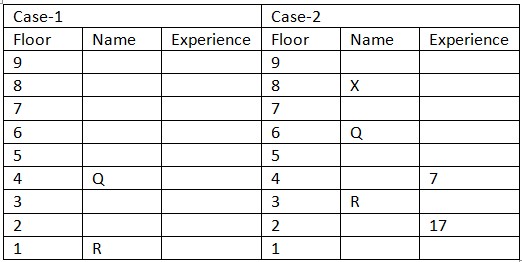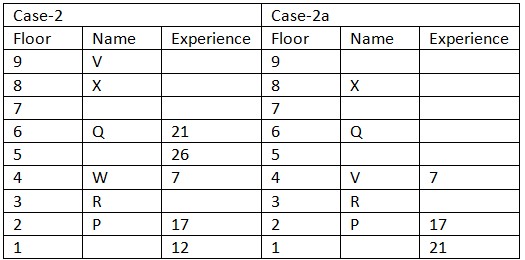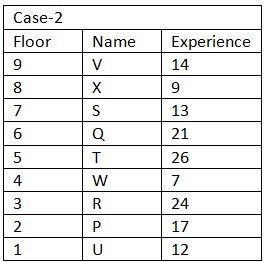Question
Who among the following lives on the eighth
floor? Study the following information carefully and answer the below questions. Nine persons namely – P, Q, R, S, T, U, V, W, and X live in a nine floored building marked 1 to 9 from bottom to top. Each person has different working experience viz.- 7, 9, 12, 13, 14, 17, 21, 24, and 26. All the information is not necessary in the same order. Note: The experience of the persons living on the adjacent floor is neither a common factor nor a common multiple. Q lives on an even number floor. R, who lives on any floor below floor number 4, lives three floors away from Q and doesn’t have experience of 12 years. W lives on any floor above the one whose experience is 12 years but not adjacent to Q’s floor. Neither Q nor R lives on the adjacent floor of X, who lives four floors away from the one whose experience is 7 years. V lives three floors above the one whose experience is 21 years. The number of persons living between Q and X is the same as the number of persons living below P, whose experience is 17 years. The number of persons living between V and the one whose experience is 26 years is one more than the number of persons living between the one whose experience is 12 years and W. Experience of X is neither 26 nor 14 years. The one whose experience is 14 years lives two floors away from S. The number of persons living between S and Q is the same as between S and the one whose experience is 9 years. W doesn’t live on the topmost floor. U has less experience than T.Solution
Q lives on an even number floor. R, who lives on any floor below floor number 4, lives three floors away from Q and doesn’t have experience of 12 years. That means, in case (2) Q lives on floor number 6, in case (1) Q lives on floor number 4. Neither Q nor R lives on the adjacent floor of X, who lives four floors away from the one whose experience is 7 years. The number of persons living between Q and X is the same as the number of persons living below P, whose experience is 17 years. That means, in case (2) X lives on floor number 8, case (1) is not valid. Based on the above given information we have:  Case (1) is not valid as the number of persons living between Q and X is the same as the number of persons living below P, whose experience is 17 years. Again, we have: V lives three floors above the one whose experience is 21 years. That means, in case (2) V lives on floor number 9, in case (2a) V lives on floor number 4. The number of persons living between V and the one whose experience is 26 years is one more than the number of persons living between the one whose experience is 12 years and W. The experience of X is neither 26 nor 14 years. W lives on any floor above the one whose experience is 12 years but not adjacent to Q’s floor. W doesn’t live on the topmost floor. That means, in case (2) the one whose experience is 12 years lives on floor number 1, case (2a) is not valid. Based on the above given information we have:
Case (1) is not valid as the number of persons living between Q and X is the same as the number of persons living below P, whose experience is 17 years. Again, we have: V lives three floors above the one whose experience is 21 years. That means, in case (2) V lives on floor number 9, in case (2a) V lives on floor number 4. The number of persons living between V and the one whose experience is 26 years is one more than the number of persons living between the one whose experience is 12 years and W. The experience of X is neither 26 nor 14 years. W lives on any floor above the one whose experience is 12 years but not adjacent to Q’s floor. W doesn’t live on the topmost floor. That means, in case (2) the one whose experience is 12 years lives on floor number 1, case (2a) is not valid. Based on the above given information we have:  Case (2a) is not valid as W lives on any floor above the one whose experience is 12 years but not adjacent to Q’s floor and W doesn’t live on the topmost floor. Again, we have: The one whose experience is 14 years lives two floors away from S. U has less experience than T. The number of persons living between S and Q is the same as between S and the one whose experience is 9 years. Since, persons whose experiences are in common multiple are not living on the adjacent floor. This, the experience of S is 13 years. Based on the above given information we have
Case (2a) is not valid as W lives on any floor above the one whose experience is 12 years but not adjacent to Q’s floor and W doesn’t live on the topmost floor. Again, we have: The one whose experience is 14 years lives two floors away from S. U has less experience than T. The number of persons living between S and Q is the same as between S and the one whose experience is 9 years. Since, persons whose experiences are in common multiple are not living on the adjacent floor. This, the experience of S is 13 years. Based on the above given information we have 
Which of the following statement is incorrect about harvest festival?
Who among the following was the last sultan of Delhi sultanate?
The pH range of a human body is:
What is the role of Amitabh Kant in G20?
Which of the following statements about the National Skill Development Corporation is/are not correct?
1. It is a not-for-profit Public Limite...
Which of the following was a Ceylonese chronicle that acted as an important literary source of the Mauryan empire?
The Mughal ruler Akbar was born in _________.
According to Census of India 2011, which of the following states recorded the least population?
Who has been appointed as the Chief Election Commissioner of the Election Commission of India (ECI) with effect from 15 May 2022?
NITI Aayog on November 23, 2021, released SDGs Urban Index 2021-22 in which total _________ urban areas were ranked.
Relevant for Exams:



